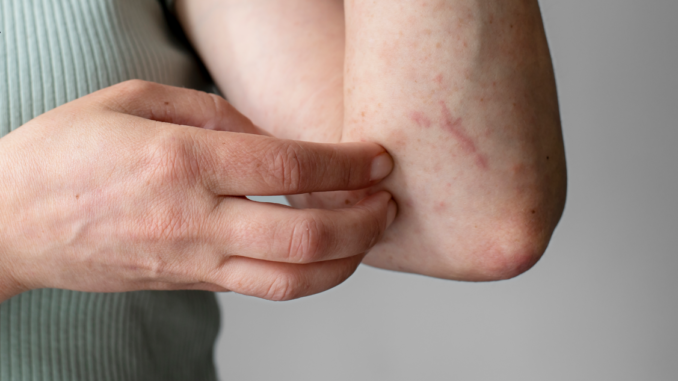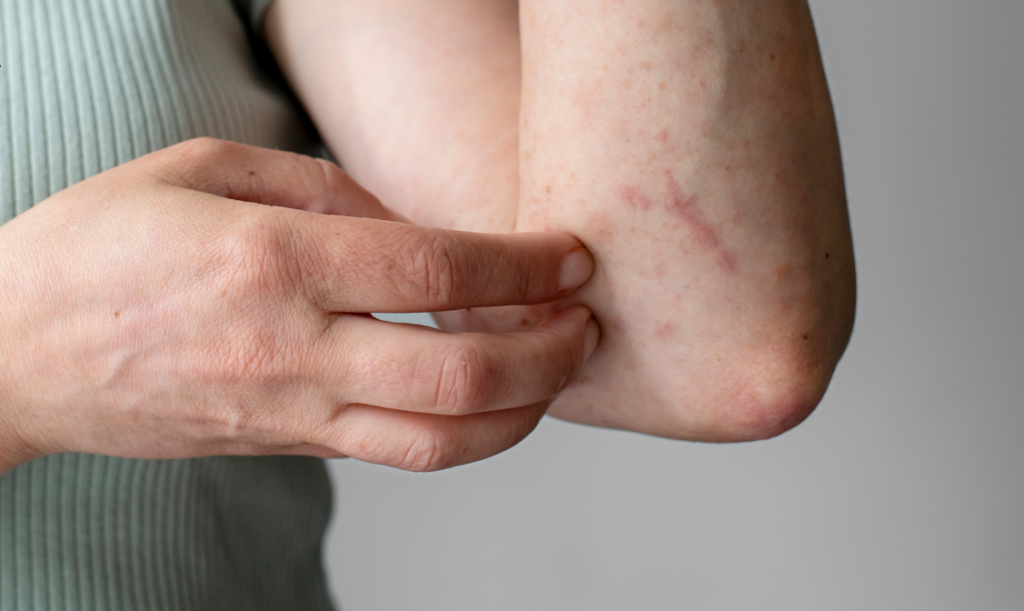
Dyshidrotic eczema is a skin disorder that is characterized by the creation of tiny blisters or fluid-filled vesicles on the palms of the hands, soles of the feet, or on both. This ailment is sometimes referred to as pompholyx or dyshidrosis.
The blisters that are so distinctive of dyshidrotic eczema normally last for around three weeks on average.
In addition to that, they itch like crazy. When the blisters eventually burst and dry up, they might leave fissures, grooves, or cracks in the skin, which can cause excruciating discomfort.
The skin condition known as dyshidrotic eczema is not contagious in any manner. As a result, it is not possible for it to pass from one person who is affected to another, even in situations where there is direct contact with the patient.
Additionally, in contrast to the vast majority of other skin illnesses, this particular kind of eczema does not spread, even after coming into contact with the fluids that pour out of the blisters.
Topical medicines, lotions, and ointments, in addition to ultraviolet light therapy, are the standard methods of treatment for dyshidrotic eczema. They help in the reduction of symptoms and also improve the general appearance of the skin that has been impacted by the condition .Additionally recommended for the alleviation of the symptoms is the application of wet compresses.
Table of Contents
Dyshidrotic Eczema – Symptoms
People who have dyshidrotic eczema are more likely to develop dermatitis or skin irritation in the parts of their skin that are affected.
As a consequence of this, the junctions that normally exist between the skin cells become more open, which in turn makes it easier for serum or fluids to accumulate in the spaces that have been created.
Due to the presence of a large number of fluid-filled regions, the surface of such skin will give the impression of being similar to a sponge when viewed through a microscope. This condition is referred to as spongiosis by medical professionals.
Following is a list of what are considered to be some of the more prevalent signs and symptoms of dyshidrotic eczema –
- The appearance of a few raised bumps, which are followed by the development of a rash that is characterized by blisters that are filled with fluid.
- Intense itching
- There is a possibility that the fingers and toes, or both, will develop cracks or ridges.
- Patients can also experience pain, particularly if huge blisters are present in the affected area.
The palms and fingers are often the sites of the little blisters that are filled with fluid. They are also capable of occasionally affecting the bottoms of the feet as well as the toes. The duration of the aberrant vesicles is often somewhere about three weeks.
It’s possible that dyshidrotic eczema won’t be much more than an irritating nuisance for the vast majority of those who have it, and that it won’t even raise the risk of serious health issues. However, some patients may find that the itching and soreness in their hands makes it difficult or impossible to use their hands.
In addition, some people who have dyshidrotic eczema may experience different types of damage to the skin, such as an increase in the thickening of the skin, as well as other forms of skin damage.
Scratching the blisters without restraint in an effort to reduce the irritation can also cause the skin to burst open, which leaves the skin susceptible to secondary infections caused by bacteria and other pathogens.
The treatment method for dyshidrotic eczema may become more time consuming and challenging as a result of such extra issues.

Dyshidrotic Eczema – Causes
It is currently unknown what the precise reason for dyshidrotic eczema is. On the other hand, it has been linked to atopic dermatitis, which is a skin condition that is very similar to atopic eczema, as well as allergic conditions such as asthma and hay fever. A condition known as dyshidrotic eczema can manifest itself in hypersensitive people whenever there is a shift in the climatic conditions.
The following is a list of some of the recognized risk factors that may represent an increased threat to the development of dyshidrotic eczema:
- Long-term or repeated exposure of the skin to water or other wet substances can cause irritation.
- When compared to men, women have a greater propensity to acquire dyshidrotic eczema than men do.
- There is some evidence that prolonged skin contact with other metals, such as nickel, chromium, or cobalt, may further increase the risk.
- People who suffer from allergies to the different seasons are more likely to have dyshidrotic eczema.
- The risk is also increased when there is a high level of stress.
Treatment for Dyshidrotic Eczema
The following is a list of potential therapies for patients suffering from dyshidrotic eczema:
- The application of corticosteroid creams and ointments can speed up the process of eliminating blisters and improving the appearance of the skin that has been affected.
Another treatment option for fissures that develop later on is the application of topical corticosteroids. - Oral steroids available by prescription are the standard treatment for moderate to severe cases of dyshidrotic eczema.
- Injections of botulinum toxin are a treatment option for severe dyshidrotic eczema that may be suggested by some medical professionals.
- Antihistamines are a medication that can help relieve itching.
Compresses that are both cold and moist can provide some relief from the itching as well. - Patients should refrain from scratching the blisters, as this might cause the skin to become irritated and open them up to the possibility of secondary infections.
- In severe cases of dyshidrotic eczema, medical professionals may recommend a treatment plan that combines medication therapy with PUVA, a specialised form of UV light therapy.
- In the event that none of the aforementioned methods of treatment are effective, medical professionals may decide to apply topical immunosuppressant drugs.
Home Remedies for Dyshidrotic Eczema
The at-home treatments that are listed below are also possible options for the treatment of dyshidrotic eczema:
Soak the problematic regions of skin in a solution of white vinegar and potassium permanganate or sea salt for approximately forty minutes, twice day, using a cloth that has been wet with the solution.
Dryness, scaling, and irritation of the skin are among symptoms that will improve as a result.
Coconut oil or ground flaxseed should be applied to the areas of the skin that have been damaged.
Instead of washing your hands with soap, try cleaning them with aloe vera gel.
When taking a bath, oatmeal or sea salts are also great options.Every day, apply moisturiser to your feet and hands to keep them healthy.
Dishwashing soap, chemicals, and any other allergens or irritants should not come into touch with parts of the body affected by dyshidrotic eczema. The hands and feet should be well protected from such contact.
The use of sunlight for brief periods of time to the areas of the skin affected by dyshidrotic eczema is another beneficial treatment.
Authoritative Clinical References
Dyshidriotic Eczema (cause of palmar dermatitis) – https://www.ncbi.nlm.nih.gov/pmc/articles/PMC7647841/
Dyshidriotic Eczema → https://bestpractice.bmj.com/topics/en-us/91


Be the first to comment